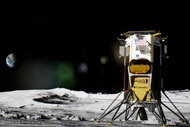Create a free profile to get unlimited access to exclusive videos, sweepstakes, and more!
What is the ultimate moon habitat made of?

As we approach the age of Artemis, there is a question that looms over the next decade. Could future astronauts really be hanging out on the moon just like they float around on the ISS for months at a time right now?
Shirley Dyke thinks so. As the head of Purdue University’s RETH (Resilient ExtraTerrestrial Habitats) Institute, she and her team are collaborating with NASA pursuing an interdisciplinary approach to lunar habitats. Because there is no shortage of potential hazards on the moon, she puts habitat concepts through physical cyber testing, a kind of virtual reality for seeing how well a structure would survive getting radiation-bombed or pelted by meteoroids. They are currently trying to see which design aspects would merge into the ultimate AI-powered smart habitat that takes care of itself.
“I’m not one who seeks to design the best something,” said Dyke, a professor of mechanical and civil engineering whose dream is to create lunar habitats that can manage and repair themselves autonomously. “I aim to bring together smart people from different disciplines to pursue goals that would not be possible otherwise. In this age, this is the most effective way to push science forward.”
Some of the physical cyber tests happen completely onscreen. The current research Dyke is even more advanced, involving cyber physical tests that incorporate realistic quarter-scale habitats. These trials can do things that would be physically impossible on the Moon or even some alien test site on Earth. You can change the circumstances in a cyber physical test faster than you ever would be able to in real life. If you’re testing out a habitat in a lunar lava tube, you can change the location to the Moon’s surface without physically rebuilding the entire thing.
The habitat characteristics which stand out the most to the RETH team are resilience, intelligence and autonomy. Resilience is exactly what it sounds like. When meteor showers hit Earth, most of those space rocks burn up in the atmosphere. The Moon’s atmosphere was blasted away billions of years ago. This explains all the craters, because anything that comes at it is going to crash. Meteoroid impacts aren’t the only dangers to watch out for. Moonquakes do happen even though the Moon has no tectonic activity, and abrasive Moon dust, littered with micro-shards of glass, is not something anyone or anything from Earth should be breathing.
For an Earth-independent permanent extraterrestrial habitat (EIPEH) system, intelligence means more than just the right AI existing. This technology has to be incorporated into the design of a particular structure depending on where the habitat is and what it is made of. This is how intelligence merges with autonomy, since a design that already has these smart capabilities should be able to survive whether or not it is inhabited. It can also be monitored by live sensors in case disaster strikes, and in the worst case scenario, robots could rush in and do whatever they needed to recover the habitat.
With all the potential disasters that could happen on the moon, another advantage of physical cyber tests is that you can predict how a habitat will put up with the elements long-term. Besides meteoroids, moonquakes and potentially lethal radiation from cosmic rays, there are also extreme temperature fluctuations and even more radiation from the sun when it throws a tantrum otherwise known as a solar storm. Then you have the possibility of equipment glitching or dying. Smart tech needs to maintain and repair itself—and know when to send for emergency-response robots.
Being able to program knowledge of all such possibilities into a computer brain could be the answer to achieving RETH’s ultimate vision of lunar habitats that know what to do in case of a threat and need no human intervention.
“Eventually, we want to develop smart habitats that can respond to changes, damage and anything that could go wrong during a mission and still maintain the integrity and safety of the science inside,” Dyke said.
When you’re literally shooting for the moon, you need to go high-tech or go home.
(via Purdue University/RETH)














